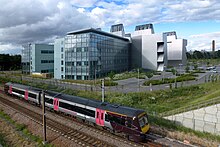MRC Laboratory of Molecular Biology

The new building of the LMB viewed from the Cambridgeshire Guided Busway bridge in June 2013
|
|
| Location |
|
|---|---|
| Coordinates | 52°10′35″N 0°08′35″E / 52.1763°N 0.1430°ECoordinates: 52°10′35″N 0°08′35″E / 52.1763°N 0.1430°E |
|
Director
|
Hugh Pelham |
|
Deputy Director
|
Venkatraman Ramakrishnan |
|
Parent organization
|
Medical Research Council |
| Website | www2 |
The Medical Research Council (MRC) Laboratory of Molecular Biology (LMB) is a research institute in Cambridge, England, involved in the revolution in molecular biology which occurred in the 1950–60s, since then it remains a major medical research laboratory with a much broader focus. A new £212m replacement building constructed close by to the original site on the Cambridge Biomedical Campus was opened in May 2013. The road outside the new building is named Francis Crick Avenue after the 1962 joint Nobel Prize winner, who co-discovered the helical structure of DNA in 1953.
The LMB has a deliberately simple administrative environment. From outside the LMB, the parent MRC ensured that the triennial assessment had a light touch: only a brief explanation of past achievements and an indication of where future plans lay were required by the external committee. Their recommendations were simply advisory, leaving the division leaders a free hand as to how to run their affairs: they were assumed to know best.
Within the LMB, Perutz’s criterion of how to arrange things was that the act of doing science should be facilitated at all levels. The LMB had a single budget: there were no personal budgets or equipment — everything was communal. It had state of the art equipment and was well financed by the MRC. Chemical reagents, glassware and other expendables could be withdrawn from a single store with only a signature required. Key to the smooth functioning of the lab was Michael Fuller, who was responsible for its day-to-day running.
There was no overt hierarchy; everyone was on first-name terms. Most members of the lab met freely in the canteen, which was said to assist inter-divisional communication and collaboration. Today the LMB has around 400 scientists, of whom 130 are postdoctoral researchers and 90 students. The new building (situated on the Cambridge Biomedical Campus) was opened in 2013 and has four seminar rooms named after LMB scientists: Sydney Brenner,Aaron Klug, the late César Milstein and Frederick Sanger,. as well as another lecture theatre named after the late Max Perutz.
...
Wikipedia
